Recent Storm Damage Posts
Mastering Post-Storm Cleanup: Debris and Fallen Trees
8/3/2024 (Permalink)
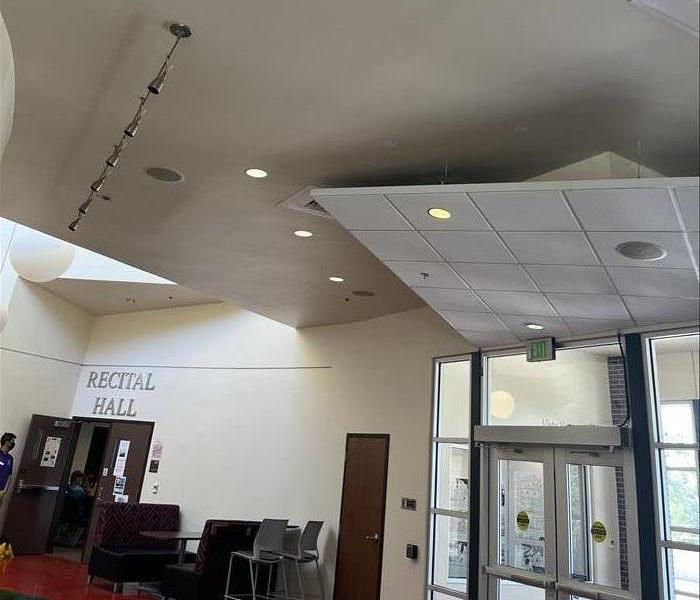 At SERVPRO®, we understand the challenges that come with storm cleanup and are here to provide expert guidance.
At SERVPRO®, we understand the challenges that come with storm cleanup and are here to provide expert guidance.
When severe storms strike, they often leave behind a trail of debris and fallen trees. This aftermath can be overwhelming for homeowners and businesses alike. At SERVPRO®, we understand the challenges that come with storm cleanup and are here to provide expert guidance on how to manage the debris and fallen trees that follow effectively.
The Impact of Storm Debris and Fallen Trees
Storms can unleash powerful winds and heavy rains, causing trees to fall and debris to scatter across properties. This not only poses safety hazards but also can lead to significant property damage. In Texas, where storms can be particularly fierce, the aftermath is often daunting.
Fallen Trees in Texas: A Startling Statistic
In Texas, the frequency and intensity of storms contribute to a high number of fallen trees. According to the Texas A&M Forest Service, an estimated 5 million urban trees were damaged or destroyed by Hurricane Harvey alone. This statistic highlights the immense scale of the problem and the need for efficient cleanup strategies.
Immediate Steps for Safe Debris and Tree Cleanup
Cleaning up after a storm requires careful planning and execution to ensure safety and efficiency. Here are the crucial steps to follow:
- Assess the Damage Safely: Before beginning any cleanup, carefully assess the damage. Look for downed power lines, unstable trees, and other hazards. Keep a safe distance from any potential dangers.
- Use Proper Safety Gear: Equip yourself with the necessary safety gear, including gloves, safety goggles, and sturdy footwear. This will protect you from sharp debris and other hazards.
- Prioritize Hazardous Debris: Focus on removing hazardous debris first. This includes large branches, broken tree limbs, and any items blocking access to your property.
- Cut and Remove Fallen Trees: Use chainsaws and other appropriate tools to cut fallen trees into manageable pieces. If the job is too large or dangerous, consider hiring professional tree removal services.
- Clear Smaller Debris: Once the major hazards are addressed, clear smaller debris such as leaves, twigs, and branches. This can be done using rakes, brooms, and leaf blowers.
Long-Term Tree Management Strategies
To minimize future storm damage, implement these long-term tree management strategies:
- Regular Tree Maintenance: Regularly trim and prune trees to remove weak or dead branches that could pose a risk during storms.
- Tree Health Assessments: Periodically assess the health of your trees. Remove any diseased or damaged trees that could fall during severe weather.
- Proper Planting Practices: When planting new trees, choose species that are well-suited to your local climate and soil conditions. Plant trees a safe distance from structures and power lines.
Conclusion
The cleanup process after a storm in San Antonio, Texas, can be challenging, but with the right approach and professional assistance from SERVPRO, it becomes manageable. Understanding the impact of storm debris and fallen trees, taking immediate action, and implementing long-term strategies are essential for maintaining a safe and beautiful property. SERVPRO is Here to Help® you navigate through the post-storm cleanup with expertise and care, ensuring your property is restored efficiently and effectively.
Be Ready, Stay Safe: Creating Your Storm Survival Kit
5/28/2024 (Permalink)
When storms loom on the horizon, being prepared can make all the difference between weathering the storm safely and facing unforeseen challenges. A well-equipped storm survival kit is a crucial component of emergency preparedness, providing essential supplies to help you and your loved ones stay safe and comfortable during and after a storm. Let's explore how to create a comprehensive storm survival kit to ensure you're ready for whatever Mother Nature throws your way.
Water and Hydration
Water is essential for survival, so ensure your kit includes an ample supply. Aim for at least one gallon of water per person per day for drinking and sanitation purposes. Consider adding water purification tablets or a portable water filter for additional purification options.
Stock up on non-perishable food items that require minimal preparation and can be eaten without cooking. Include items such as canned goods, protein bars, dried fruits, nuts, and granola bars. Choose foods with a long shelf life and rotate them periodically to maintain freshness.
First Aid Kit & Lighting
A well-stocked first aid kit is essential for treating minor injuries and medical emergencies. Include bandages, gauze pads, adhesive tape, antiseptic wipes, pain relievers, tweezers, scissors, and any necessary prescription medications. Familiarize yourself with basic first aid procedures and keep a manual or guide book handy.
In the event of a power outage, reliable lighting sources are essential for navigating darkened spaces safely. Pack flashlights, headlamps, lanterns, and spare batteries to ensure you have ample illumination. Consider including glow sticks or candles with matches as backup options.
Communication Devices & Shelter
Maintain communication with loved ones and emergency services by including communication devices in your kit. Pack a battery-powered or hand-crank radio to receive emergency alerts and updates. Don't forget to include a fully charged mobile phone with a portable charger or backup battery.
Be prepared for inclement weather by including items to keep warm and sheltered. Pack warm blankets, sleeping bags, or emergency thermal blankets to retain body heat. Additionally, include waterproof ponchos, tarps, or emergency shelters to protect against rain and wind.
Tools and Multi-Purpose Items
Equip your kit with a selection of versatile tools and multi-purpose items to address various needs. Consider including a multi-tool, duct tape, rope, utility knife, whistle, and matches or a lighter. These items can prove invaluable in a wide range of situations.
Maintain hygiene and sanitation standards even in emergency situations by including personal hygiene items in your kit. Pack items such as hand sanitizer, moist towelettes, toilet paper, feminine hygiene products, and disposable gloves. Don't forget to include a small shovel or trowel for waste disposal.
Important Documents and Cash
Safeguard essential documents and valuable items by storing copies in your kit. Include photocopies of identification, insurance policies, medical records, and emergency contact information. Keep cash in small denominations for purchasing supplies or accessing services if electronic payment methods are unavailable.
While safety is paramount, maintaining morale during stressful situations is also important. Include items to keep spirits up and provide entertainment. Pack books, playing cards, puzzles, or other small games to pass the time and distract from the storm's intensity.
By assembling a comprehensive storm survival kit and regularly reviewing its contents, you can be better prepared to face the challenges of severe weather events. Remember to customize your kit based on your family's unique needs and preferences and store it in a readily accessible location. With proper preparation and foresight, you can enhance your resilience and readiness for whatever storms may come your way.
How To Protect Your Electronics During Storms
9/28/2023 (Permalink)
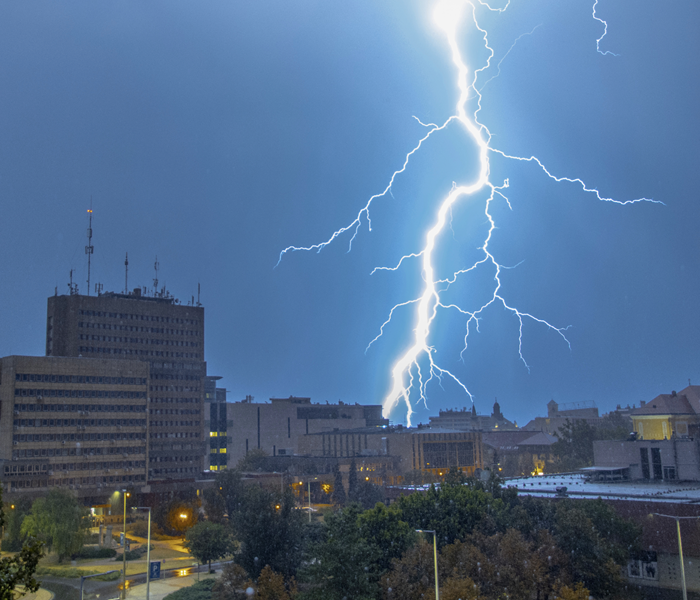 Protecting your electronics during storms require proactive measures and preparedness.
Protecting your electronics during storms require proactive measures and preparedness.
Storms can be a significant threat to your electronics. Power surges and lightning strikes can cause costly damage to your devices. Protecting your electronics during storms is essential to minimize the risks of electrical damage, data loss, and even fire hazards. In this blog post, we will discuss some practical tips to safeguard your electronics during storms.
Unplug Your Electronics
One of the easiest ways to protect your electronics during a storm is to unplug them. Unplug all your electronic devices, including computers, TVs, gaming consoles, and home appliances. This will minimize the risk of power surges and protect your devices from lightning strikes. Ensure that you turn off and unplug all electronics before leaving your home or going to bed.
Installing surge protectors in your home is an effective way of protecting your electronics from power surges. A surge protector can absorb excess electricity and prevent it from reaching your devices, thus reducing the risk of electrical damage. Invest in high-quality surge protectors that protect against both voltage surges and frequency surges. Make sure you plug all your electronics into the surge protectors for maximum protection.
Invest in an Uninterruptible Power Supply (UPS)
An uninterruptible power supply (UPS) is a backup system that provides power to your electronics during power outages. A UPS provides temporary power to your electronics, giving you sufficient time to save your work and shut down your devices safely. Investing in a UPS can also protect your devices from voltage fluctuations and power surges. Choose a UPS that's compatible with your electronics and has enough capacity to meet your power needs.
Protect Your Electronics from Water Damage
Storms can also cause water damage to your electronics. Protect your devices from water damage by keeping them away from windows and doors during a storm. If possible, move them to higher ground or a dry area. Cover your electronics with plastic bags or waterproof covers to keep them dry. If your electronics get wet during a storm, turn them off, unplug them, and don't use them until they are fixed.
Using battery-powered devices during a storm can also protect your electronics from electrical damage. Use battery-powered lamps, flashlights, and radios instead of lighting and appliances that rely on the power grid. Battery-powered devices are less vulnerable to power surges and electrical damage during a storm. Keep extra batteries on hand and replace them regularly to ensure your devices are always ready when you need them.
Backup Your Data
Data loss is another risk associated with electrical storms. Protect your data by backing it up to an external hard drive or cloud storage. This will ensure that your important files are safe in case of electrical damage or data loss. Back up your data regularly, so you always have the latest version of your files.
If you have an outdoor antenna or dish, turn it off and unplug it during a thunderstorm. Lightning strikes can damage these devices, causing costly repairs and endangering anyone nearby. Turning them off and unplugging them will protect them from lightning strikes and prevent electrical damage to your home.
Protecting your electronics during storms requires proactive measures and preparedness. Unplug your electronics during a storm, install surge protectors, and invest in an uninterruptible power supply. Protect your electronics from water damage, use battery-powered devices, and backup your data regularly. Consider turning off and unplugging your electronics antenna or dish during a thunderstorm. By implementing these strategies, you can significantly minimize the risk of electrical damage, data loss, and even fire hazards to your electronics during a storm.
Battling the Gusts: Effective Strategies to Mitigate Wind Damage and Protect Your Property
6/12/2023 (Permalink)
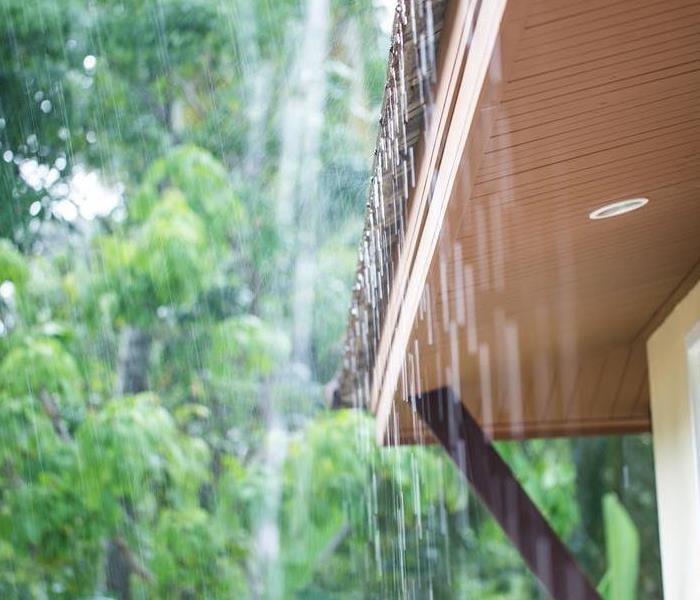 Protect your home from wind damage.
Protect your home from wind damage.
Windstorms can be powerful and destructive, causing extensive damage to homes and properties. However, by implementing proactive measures and employing the right strategies, you can mitigate the risk of wind damage and protect your property. In this blog, we'll explore essential techniques and practical tips to help you fortify your home and minimize the potential impact of strong winds.
Strengthen Your Roof
Ensure that your roof coverings, such as shingles or tiles, are properly installed and in good condition. Replace any damaged or missing materials promptly. Strengthen the connections between your roof and the underlying structure by using hurricane straps or clips. These metal connectors can help withstand strong winds and prevent roof uplift.
Reinforce Doors and Windows
Consider investing in impact-resistant doors and windows designed to withstand high winds and flying debris. These reinforced components provide an extra layer of protection against wind infiltration and damage. Install storm shutters or impact-resistant window coverings to shield your windows from airborne debris during severe weather events.
Secure Outdoor Items
Secure or bring indoors any lightweight outdoor objects, such as patio furniture, grills, and potted plants. Anchor heavier items, such as sheds or playsets, to prevent them from being lifted or toppled by strong winds. Regularly trim trees near your home and remove dead or weak branches that could potentially break off and cause damage during a windstorm.
Reinforce Structures
Strengthen garage doors by installing a bracing system or reinforcing with additional bolts. Garage doors are particularly vulnerable to wind damage and can lead to significant structural failure if not properly secured. Ensure that fences and gates are in good condition and securely fastened. Reinforce weak areas and repair any loose or damaged sections to minimize the risk of them being blown over or collapsing.
Perform Regular Maintenance
Regularly inspect the exterior walls of your home for cracks, gaps, or deteriorated areas. Seal any openings to prevent wind-driven rain from entering and causing further damage. Keep gutters and downspouts clear of debris to ensure proper water drainage. Clogged gutters can overflow, leading to water damage and potential structural problems during heavy rainfall combined with strong winds.
Stay Informed and Prepared
Stay informed about weather conditions and severe storm warnings in your area. Pay attention to local weather forecasts and advisories to allow ample time for preparation. Create an emergency plan for your household, including procedures for sheltering during severe weather events. Prepare an emergency kit containing essential supplies such as food, water, medications, flashlights, and batteries.
Mitigating wind damage requires a combination of proactive measures, regular maintenance, and preparedness. By strengthening your roof, reinforcing doors and windows, securing outdoor items, reinforcing structures, performing regular maintenance, and staying informed, you can significantly reduce the risk and impact of wind damage to your property. Prioritize safety and take the necessary steps to protect your home, ensuring that it remains a safe haven during strong windstorms.
3 Ways Exterior Maintenance Can Reduce Storm Damage
7/1/2022 (Permalink)
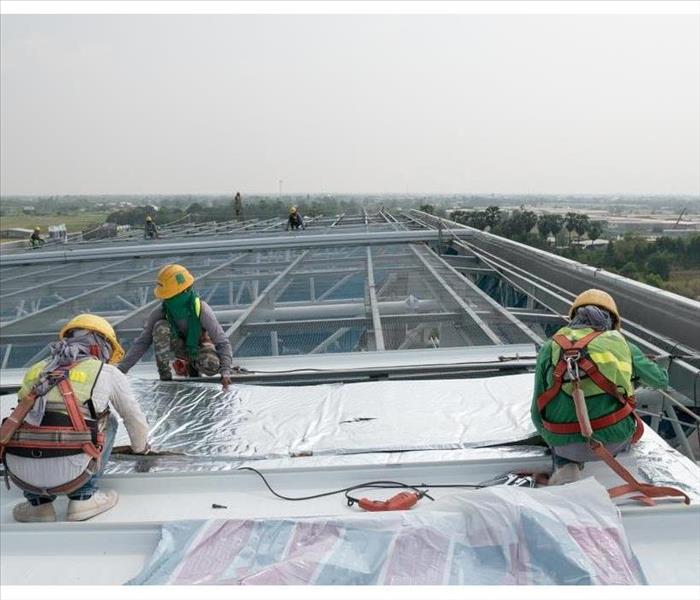 Failure to address flaws with a facility's exterior can allow a strong storm to enter the facility's interior.
Failure to address flaws with a facility's exterior can allow a strong storm to enter the facility's interior.
3 Ways Exterior Maintenance Can Help You Avoid Storm Damage
As every property manager knows, keeping up on exterior maintenance can pay big dividends. Failure to address shortcomings with the exterior of a facility can allow a strong storm to penetrate into the interior of a facility in San Antonio, TX. Therefore, a regular maintenance program by professional contractors is likely to strengthen the bottom line. A building maintained to high standards offers protection in several ways.
1. It Reduces Wind Damage.
Strong walls, a newer roof and modern windows can fight off the effects of high winds. Sustained wind gusts will seek out the weakness in a building and tear off gutters, increase the size of cracks and even break windows. A regular building inspection can locate weaknesses and schedule timely repairs.
2. It Repels Water.
Incessant rain is notorious for finding the shortcomings of a building's defenses. Looking at the roofing system should be the centerpiece of any exterior maintenance program. Any time water is allowed into a facility, it can wreak havoc with electrical systems, increase the likelihood of mold formation and break down materials. The services of a professional storm mitigation team will be needed if too much water enters.
3. It Keeps Everyone Safe.
A poorly maintained building is full of dangers for employees and customers. In the midst of a storm, items can fall from the roof and pose a threat to passersby. This could expose a company to liability lawsuits. Also, water entering the building could pose electrical shock hazards as well as increasing the possibility of trips and falls. A secure building exterior is safer for everyone.
Storms cause billions of dollars in damages every year to U.S. companies. There are numerous ways to minimize the possibility of property damage and injuries from storms. A strong exterior maintenance program is one of the best ways to ward off damage from hail, hurricanes and tornadoes. It offers an additional layer of protection for a business.
3 Tips for Conducting Effective Fire Drills at Work
6/1/2022 (Permalink)
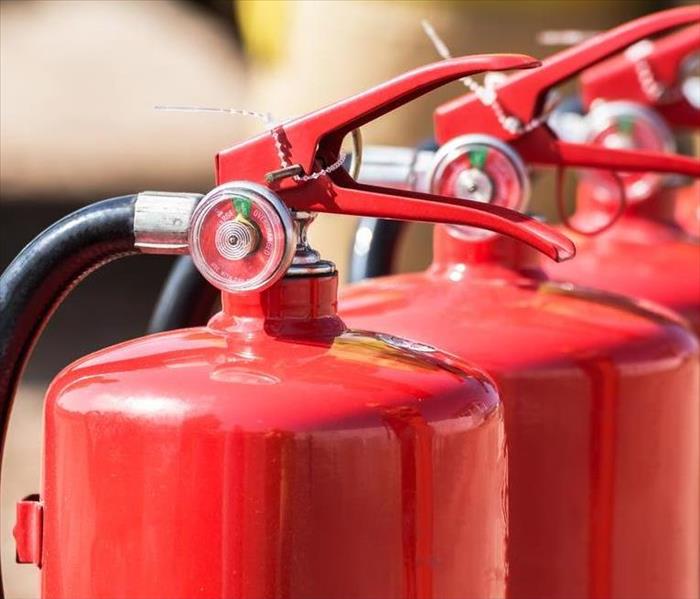 Have a plan so that you can get back to business quickly and safely after a fire. SERVPRO can help you, call us!
Have a plan so that you can get back to business quickly and safely after a fire. SERVPRO can help you, call us!
3 Tips For Conducting Effective Workplace Fire Drills
As a business owner or manager, you care about your employees and their safety. Emergency preparedness against disaster is an important part of maintaining a safe workplace. Make sure that your employees are prepared for the event of a fire in San Antonio, TX, by using these three tips to make your fire drills more effective.
1. Start with a Plan
Before jumping into a drill, make sure that you start with a detailed plan. Here are a few items to include:
Map out evacuation routes. Keep these posted in visible areas. Mark the location of fire extinguishers.
Designate an employee to act as fire warden. Assign other responsibilities as needed, such as shutting down equipment or helping at-risk individuals out of the building.
Decide on follow-up communication. Have a system for determining whether everyone has been safely evacuated. Identify a set meeting place outside the building.
Know who you will call for fire cleanup and restoration after the emergency has passed. Have a plan so that you can get back to business quickly and safely.
2. Set Fire Drill Goals
Set specific objectives for each fire drill. These could include improving evacuation time (assign someone to clock this, such as the fire warden) or efficiently shutting down necessary equipment. Make and keep a goal for the frequency of fire drills. Plan on at least two to three each year.
3. Evaluate After the Drill
After you've completed a fire drill, take the time to debrief with your employees. Discuss what went well and make specific observations about needed improvements. Ask for feedback from everyone involved to identify any hiccups that need to be worked out before the next drill.
Drills are an important way to prepare for potential emergencies in the workplace. Make the most of your time, and that of your employees, by ensuring that your drills are effective. Plan ahead, be specific in your objectives and take the time to communicate both before and after drills.
4 Ways To Prepare Your Business for a Thunderstorm
5/1/2022 (Permalink)
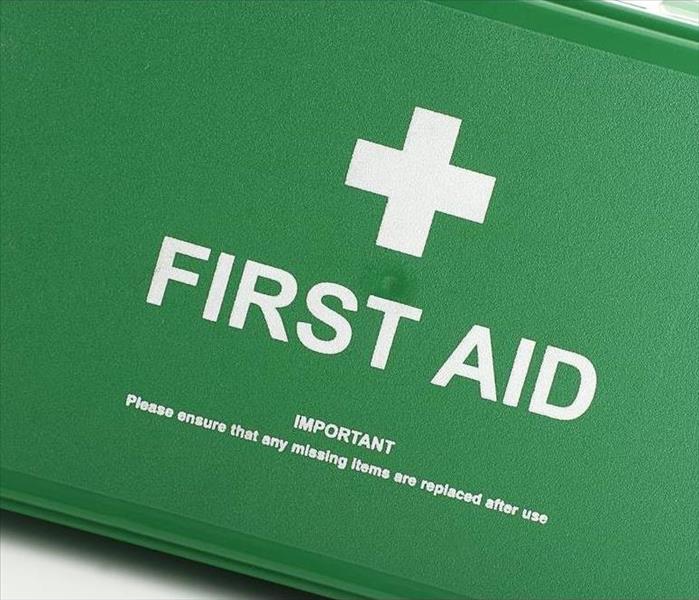 In the event that one of your colleagues is injured during a storm, you'll want to know first aid.
In the event that one of your colleagues is injured during a storm, you'll want to know first aid.
4 Ways To Get Your Business Ready For A Storm
You're probably used to experiencing thunderstorms in your San Antonio, TX, business building. However, you may experience one or more that are potentially dangerous, possibly to the point of requiring storm damage restoration. If this occurs, you'll want to be ready. So, here are four ways to prepare your business for a thunderstorm.
1. Make a Safety Plan
One of the most important things to do in this process is to make a plan of action. First, start by conducting a walk-through of your building. You'll need to find places for everyone to go during a storm with high winds. Look for areas that are away from the following:
- Windows
- Highly breakable glass
- Skylights
Once these spots have been located, be sure to let your employees know about each one. If you can, you may want to create signage as a reminder.
2. Keep Trees Trimmed
Trees can be dangerous during a storm, especially if some aren't kept trimmed. If a strong enough wind blew during a rain storm, a tree or its branches could fall and cause significant damage to your building. Fortunately, trimming trees allows the plants to better resist the wind.
3. Use Lightning Rods
Lightning rods serve as protection for buildings from lightning strikes. Be sure to get these rods installed if your building doesn't have any. If you do have lightning rods, get each one inspected on a regular basis. You don't want your protection to stop working during a rain storm.
4. Learn First Aid
In the event that one of your colleagues is injured during a storm, you'll want to know first aid. Be sure that you or someone reliable on your staff is knowledgeable in this regard. You'll also want to have some backups in case that individual isn't present.
Preparing for a dangerous rain storm is an important task for any business owner. No matter how high or low your area's storm risk is, be sure to give the preparation process your full attention.
5 Things To Expect From Damage After a Storm
3/8/2022 (Permalink)
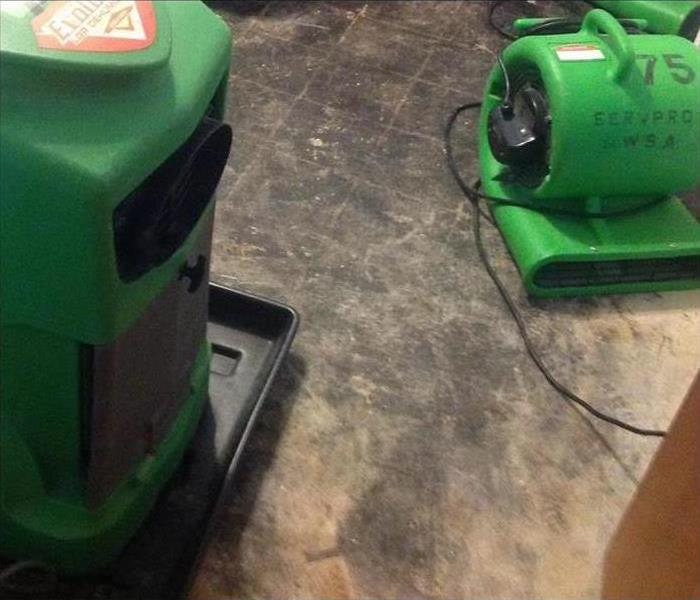 This room was flooded by rising waters. If you need a storm restoration team, please contact SERVPRO.
This room was flooded by rising waters. If you need a storm restoration team, please contact SERVPRO.
Damage After A Storm: Here's What to Expect
If your business has experienced water damage after a flood or a storm in San Antonio, TX, it can be overwhelming to know how to begin the recovery process. Here are five things to expect as you navigate a restoration.
1. Remove Standing Water
The most important first step is to remove the standing water from the building. The longer standing water remains, the more damage it does to your property. To avoid needing to tear out every last bit of dry wall and flooring, use a water pump to remove water. For small problems, a shop vacuum might work, but for bigger floods, a more specialized pump will be needed.
2. Inspect for Safety
Once the water is gone, the entire building will need to be carefully inspected for safety. A storm restoration team will have the necessary tools to inspect the areas behind walls to see where water has infiltrated.
3. Salvage or Scrap
After a thorough safety check has been conducted, decisions need to be made about the materials in your business. Some furniture and hardwoods can be salvaged, while it is often necessary to scrap drywall and ceiling tiles. Work with professionals who can help you know what all can be salvaged before you start to tear out everything. Salvaging can save you a lot of money in repairs.
4. Dry Thoroughly
Now that you're down to bare bones, everything needs to be dried out completely in order to prevent mold growth and structural damage. Pay special attention to crawl spaces, attics, and spaces beneath porches or decks. Untended mold that grows in those areas can cause more damage down the road once you believe that the restoration process is over.
5. Restore and Restart
Finally, your property can be restored to its former glory and you can focus on getting back to work.
Don't allow a restoration to overwhelm you. Before you tear out everything, work with professional restorers to help you navigate the process.
 At SERVPRO®, we understand the challenges that come with storm cleanup and are here to provide expert guidance.
At SERVPRO®, we understand the challenges that come with storm cleanup and are here to provide expert guidance.






 24/7 Emergency Service
24/7 Emergency Service





